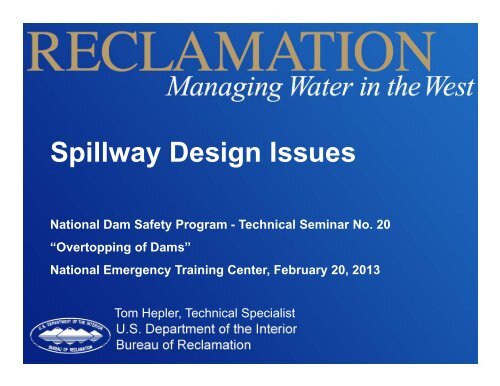Spillway Design Issues - Association of State Dam Safety Officials
Spillway Design Issues - Association of State Dam Safety Officials
Spillway Design Issues - Association of State Dam Safety Officials
- No tags were found...
Create successful ePaper yourself
Turn your PDF publications into a flip-book with our unique Google optimized e-Paper software.
<strong>Spillway</strong> <strong>Design</strong> <strong>Issues</strong>National <strong>Dam</strong> <strong>Safety</strong> Program - Technical Seminar No. 20“Overtopping <strong>of</strong> <strong>Dam</strong>s”National Emergency Training Center, February 20, 2013Tom Hepler, Technical Specialist
Conventional Solutions forHydrologic Deficiencies(Accommodating Larger Floods)
Problem IdentificationHydrologic deficiencies at an existing dammay be identified as a result <strong>of</strong>:• Regular dam safety program– Mandated by regulators (e.g. FERC, <strong>State</strong> agencies)– Comprehensive review <strong>of</strong> dam design and performance• Change in design criteria or guidelines– New design flood (change in hydrology or hazard class)• Availability <strong>of</strong> new information– <strong>Dam</strong>age or poor performance at low discharges
Inspection <strong>of</strong> Non-Federal <strong>Dam</strong>s• National <strong>Dam</strong> InspectionAct <strong>of</strong> 1972 authorized theCorps <strong>of</strong> Engineers toinventory (NID) and inspectnon-Federal dams• Over 9,000 high-hazarddams inspected 1978-81• About one-third found tobe unsafe, most due toinadequate spillwaycapacity
Problem AssessmentFlood routings may indicate:• <strong>Dam</strong> overtopping potential• Potential structural instability• <strong>Spillway</strong> chute overtopping potential• Potential for spillway failure due to:– Cavitation damage (due to high flow velocities)– Uplift failure due to stagnation pressures– Foundation failure from scour erosion– Tunnel pressurization (due to higher reservoir head)
<strong>Dam</strong> Overtopping <strong>Issues</strong>• Failure <strong>of</strong> dams due to overtopping is a commonfailure mode, accounting for 30 percent <strong>of</strong> thefailures in the U.S. over the last 75 years• Many older dams may have been designed for floodsthat no longer represent a remote flood event• Many dams can not pass the current ProbableMaximum Flood without overtopping• Most embankment dams would likely not withstandsustained overtopping <strong>of</strong> a foot or more without ahigh probability <strong>of</strong> failure
Embankment <strong>Dam</strong> OvertoppingSouth Fork <strong>Dam</strong>, PA – 1889 (Artist’s Rendition)
Embankment <strong>Dam</strong> OvertoppingAuburn C<strong>of</strong>ferdam, CA - 1986
Embankment <strong>Dam</strong> OvertoppingTaum Sauk <strong>Dam</strong>, MO - 2005
Concrete <strong>Dam</strong> OvertoppingGibson <strong>Dam</strong>, MT
Structural InstabilityAustin <strong>Dam</strong>, PA
<strong>Spillway</strong> Chute OvertoppingEl Guapo <strong>Dam</strong>, Venezuela
<strong>Spillway</strong> Cavitation <strong>Dam</strong>ageGlen Canyon <strong>Dam</strong>, UT
<strong>Spillway</strong> Chute Uplift FailureBig Sandy <strong>Dam</strong>, WY
<strong>Spillway</strong> Foundation ErosionHyrum <strong>Dam</strong>, UT15
<strong>Spillway</strong> Basin Sweepout16
<strong>Spillway</strong> Channel Toe Erosion
Unlined <strong>Spillway</strong> Erosion
<strong>Spillway</strong> Debris PluggingKerckh<strong>of</strong>f <strong>Dam</strong>, CA19
Folsom <strong>Dam</strong>, CA<strong>Spillway</strong> Gate Failure
Conventional Solutions• Increase flood storage by:– Raising dam crest– Reducing reservoir level before flood season(non-structural alternative)• Increase spillway capacity by:– Modifying existing spillway– Constructing new spillway• Improve spillway performance
Embankment <strong>Dam</strong> RaiseExisting Crest ElevationNew Crest ElevationNew EmbankmentExistingEmbankmentEmbankmentRetaining StructureExisting Crest ElevationNew Crest ElevationExistingEmbankmentRetaining StructureLake Sherburne <strong>Dam</strong>, MT
Embankment <strong>Dam</strong> RaiseLake Sherburne <strong>Dam</strong>, MTReinforced Earth Raise• Lower cost ($3.6 million)• Much less material• Single constructionseason• No outlet worksmodification• No downstream impact toenvironmental area
Embankment <strong>Dam</strong> RaiseHorseshoe <strong>Dam</strong>, AZ
Concrete <strong>Dam</strong> RaiseTheodore Roosevelt <strong>Dam</strong>, AZBartlett <strong>Dam</strong>, AZ25
Structural Stability ModificationsStewart Mountain <strong>Dam</strong>, AZPost-tensioned AnchorsSanta Cruz <strong>Dam</strong>, NMRCC Buttress26
<strong>Spillway</strong> Modifications• Increase discharge capacityTheodore Roosevelt <strong>Dam</strong>New Gated <strong>Spillway</strong>s, AZStewart Mountain <strong>Dam</strong> Gated Auxiliary<strong>Spillway</strong> (foreground), augmentingdischarge capacity <strong>of</strong> Gated Service<strong>Spillway</strong> (background)27
<strong>Spillway</strong> Modifications• Increase discharge capacity (continued)Bartlett <strong>Dam</strong> Fuseplug <strong>Spillway</strong>, AZNew Waddell <strong>Dam</strong> Fuseplug <strong>Spillway</strong>, AZ28Horseshoe <strong>Dam</strong> Fuseplug <strong>Spillway</strong>, AZ
<strong>Spillway</strong> Modifications• Increase discharge capacity (continued)Ute <strong>Dam</strong> Labyrinth <strong>Spillway</strong>, NM29
<strong>Spillway</strong> Modifications• Improve spillway performanceMcPhee <strong>Dam</strong> Chute Air Ramp, COHoover <strong>Dam</strong> Tunnel Air Ramp, AZ-NV30
Conventional SolutionsFeasibility <strong>Design</strong>s• Site investigations (geology, topography)• <strong>Design</strong> layouts – combinations <strong>of</strong> dam raiseand increased spillway capacity• Cost estimates and construction schedulesEnvironmental Analyses (normally EIS)• Evaluate range <strong>of</strong> reasonable alternatives• Identify environmental impacts and mitigation• Select preferred alternative or proposed action
General <strong>Design</strong> Guidelines• Provide a structural/non-structural solutionthat safely accommodates design flood• Consider discharge capacity <strong>of</strong> spillway(s)and increased flood loading on dam• Establish flood operating criteria• Identify potential failure modes and estimaterisks to downstream population• Consider reliability <strong>of</strong> flood release featuresand freeboard needed for dam
What if conventional solutionsare found to be impractical orcost prohibitive?
Overtopping Protection OptionsMost applicable for following situations:• Very low annual probability <strong>of</strong> operation– Generally 1 percent or lower (>100-year flood)• Physical or environmental constraints onother more conventional solutions– e.g. Deep canyon site with no reservoir saddle• Prohibitive cost <strong>of</strong> other alternatives– Expensive spillway tunnel or lake-tap alternatives– Massive open-cut channel excavation alternatives– Extensive dikes needed for crest raise
Concrete <strong>Dam</strong>Overtopping Protection35Coolidge <strong>Dam</strong>, AZ
Embankment <strong>Dam</strong>Overtopping ProtectionBlue Ridge Parkway <strong>Dam</strong>s, NC
Overtopping Protection Benefits• Increasingly being viewed as a viablealternative to more conventional solutions,while maintaining hydraulic conditions at dam• Potential economic advantages• Wider variety <strong>of</strong> materials and methods beingdeveloped and tested for field use• Becoming more accepted by regulatoryagencies as experience grows• But be aware <strong>of</strong> potential limitations, failuremodes, and risks!
Questions?
















